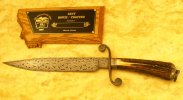Okay, my .02's worth, and really, after all these years of hanging out on BF, it's barely .02's worth of what I realize the collective knowledge here is worth!

It's already been stated, and it's what I agree with, that the knives originally attributed to the "Bowie" school of blade style were really large butcher knives, in essence... Something to remember: at this time, blacksmiths were who made the blades, and they didn't always have access to fancy materials to make handles, guards etc... So, guards were usually left off - it was considered that guards were actually meant to catch, deflect, or otherwise protect the hand from an opponents' blade in an actual fighting scenario, as indicated by most schools of blade fighting, wether sword, cutlass, dagger or knife. And while the blacksmiths may have had good knowledge of simple heat-treating, they may not have been into fancy blade shapes - they made what would work for people who actually relied on knives to do every day chores.
Only in the more "industrialized" cities were there makers who pursued more specialized blades - like swords, rapiers, scalpels, etc. And as they were making them more for city-folk or the genteel, they could afford to either make what the customer wanted, or what was being purchased in bigger lots, like the military. This is where the English influence, from Sheffield, and from Germany, the Solingen factories, came to predominate in the the aftermath of the Sandbar Fight... They began influencing what we now envision as a Bowie or a Fighter, and they derived much of thier styles from what they had been making over the previous decades, similar to what someone here has already indicated.
Also, one must understand; just as in the Orient, where a Samurai family would remount a broken Katana down to either a Waki or a Tanto, many cutlasses and swords that were used throuhgout the Americas that broke would be remounted as knives...
While we see that many feel the original "Bowie" knife was most likely a large butcher knife, it can be seen that the derivation of the clip point was most likely the result of a broken cutlass being remounted, as most cutlasses, both Naval and Cavalry issue, have the clip point we now associate with the classic "Bowie" knife. One area in particular that I believe would really hilight this history would be the larger knives found every now and again in Old Mexico. Remember, in the period of Bowie, the Mexico border was pretty transparent in those days, and both their culture and that of the Europeans moving into the Texas, New Mexico, Arizona and California territories intermixed and overlapped all the time.
Now, all of the above is pretty much my opinion, but it has been formed from a lot I have read on the Forums, and from a lot of books in my collection and a little from the History I spent the first three years of College on. But, if anyone can offer me more, either validation or clarification, on what I've stated, I would really appreciate it!

Now, as to the differnce between a Bowie and a Fighter? Well, I like the argument that a Bowie is a fighter, but a Fighter isn't neccessarily a Bowie!!!

Other than that, I think most of my personal collection would be characterized as Fighter Bowies, or Hunter/Fighters... But they mostly evidence some sort of clip-point, a double guard (or if no guard, some sort of choil or swelling at the front of the handle) and a tip pretty much in line with the centerline of the knife...
Now, back to our regularly scheduled program, and the hopes that y'all will continue to enlighten me as I keep seeming to spend my money on sharp, pointy things!!!



